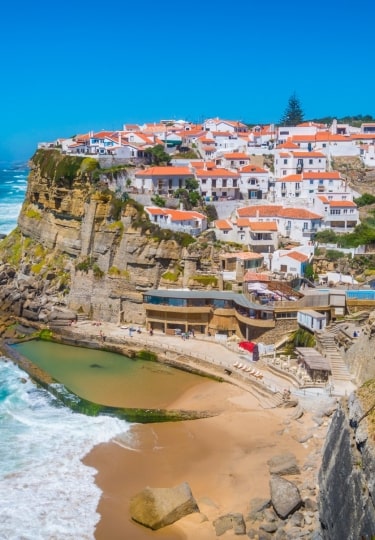Portugal’s 1,155 miles of scenic shoreline, all craggy cliffs, golden beaches, and wave-carved caves, have earned the country enviable fame. But it’s not just the bays and barrier islands that make this coastline glimmer. The best beach towns in Portugal are equally enchanting.
From chic coastal retreats near Lisbon to wildlife-watching hotspots on the county’s remote islands, Portugal’s coastal towns are as diverse as the country’s beaches.
Whether you want to learn about the nation’s nautical history, sample the freshest seafood, seek out surf-friendly swells or glimpse medieval fortifications, these are some of the best beach towns in Portugal to visit.
Câmara de Lobos
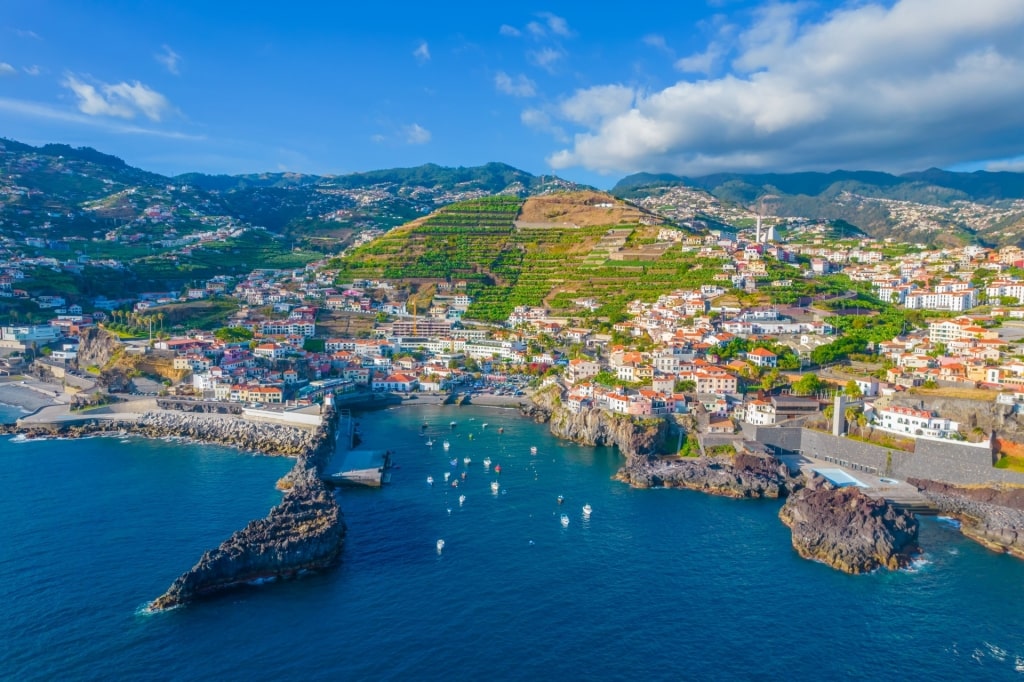
Câmara de Lobos
Câmara de Lobos—a harbor-hugging, cliff-climbing coastal town on the remote island of Madeira—has tantalized travelers for centuries. Not only is the setting utterly gorgeous, but the laid-back town retains something of a bygone aura.
Hand-painted fishing boats bob in the idyllic bay, their captains usually playing cards on nearby tables. Vineyards and banana plantations cascade down the verdant slopes, and the photogenic streets are adorned with upcycled art.
Long a muse for artists, this indelible panorama has inspired the likes of Winston Churchill, the fabled former Prime Minister of the United Kingdom, whose painting vacation here has been memorialized by a statue.

Câmara de Lobos
Along the shorefront, Praia do Vigário is one of the best beaches in Madeira, providing bathing opportunities in the shadow of Cabo Girão, a soaring sea cliff. Nearby, an open-air swimming pool presents a more tranquil dip.
Post-swim, refresh with one of the island’s signature drinks. Poncha, a sweet cocktail crafted from honey, sugar, juice and Madeira’s sugarcane rum, was invented in Câmara de Lobos.
Once the preferred beverage of local fishermen, it has since become a popular drink across the island. For a more refined quencher, visit Henriques & Henriques, a respected winery offering tastings of fortified Madeira wine.
Cascais
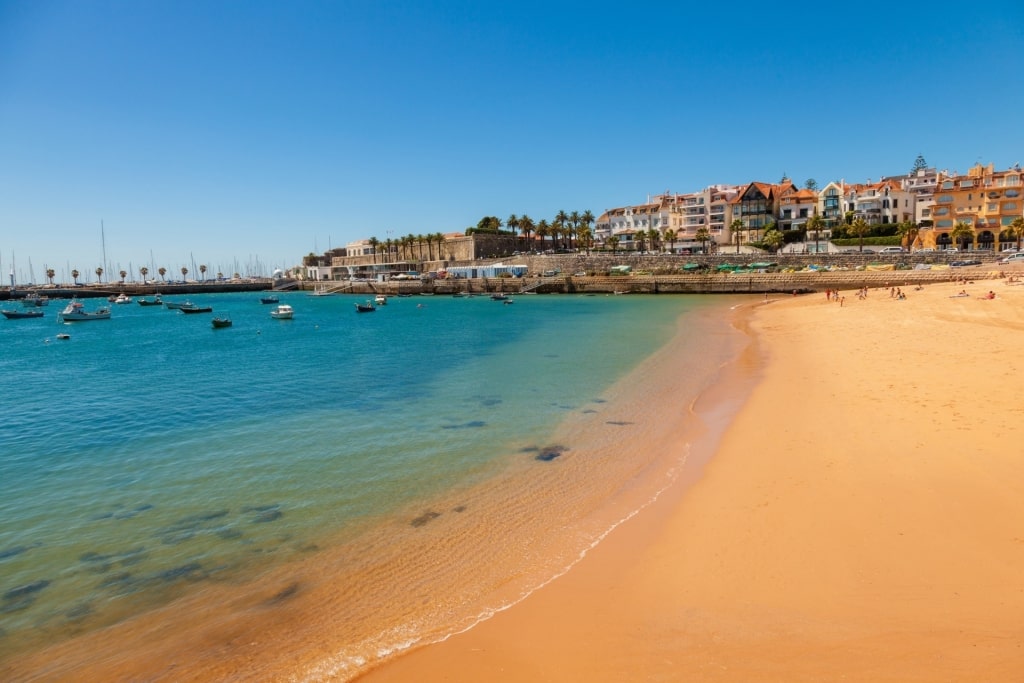
Cascais
Once you’ve ridden Lisbon’s iconic trams and explored Belem’s cultural highlights, take the short hop by train to chic Cascais.
Long adored by well-heeled holidaymakers, this coastal escape was once the preferred summer retreat for royals seeking respite from the heat of the country’s capital.
Nowadays, Cascais is considered one of the best beach towns in Portugal. Here you’ll find a fetching historic center embellished with calçadas (decorative pavements), heritage buildings, and a plethora of straight-from-the-boat seafood restaurants and inviting beaches that Portugal is famous for.
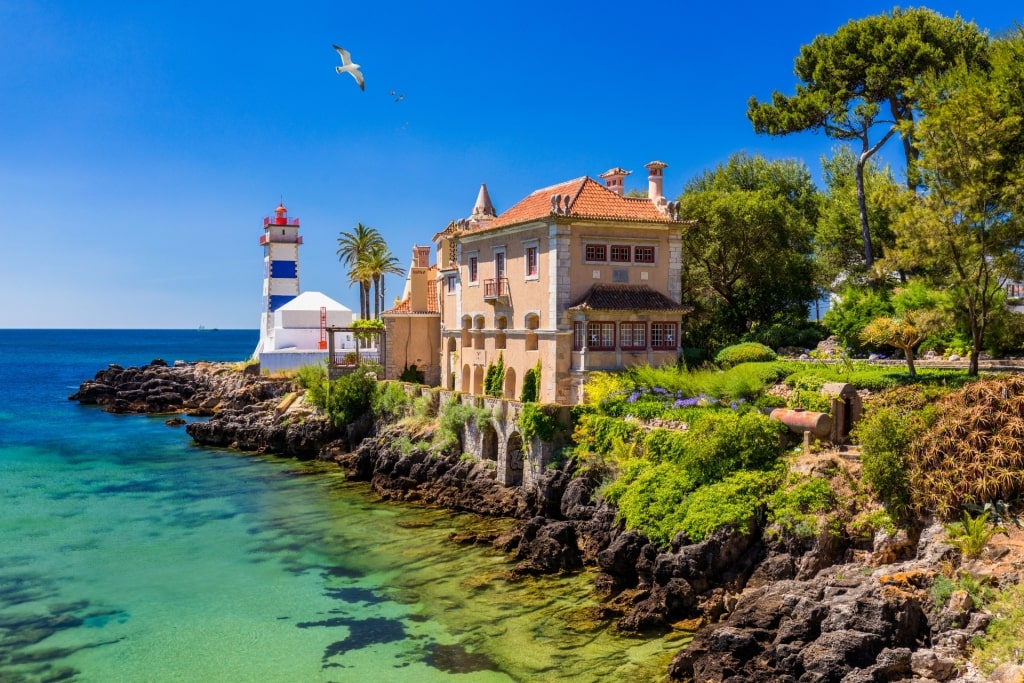
Casa de Santa Maria, Cascais
Stately homes, forts and former palaces, such as Casa de Santa Maria and the Citadel of Cascais, pay homage to the town’s former status. Many of these have now been converted into cultural institutions and museums.
Along the waterfront, the promenade snakes from Cascais to Praia da Duquesa and the oceanfront natural pool of Piscina Oceânica Alberto Romano.
For more untouched sands, detour slightly out of the town to dune-backed Praia do Guincho, where kitesurfers and swell-seekers embrace the Atlantic winds.
Ponta Delgada
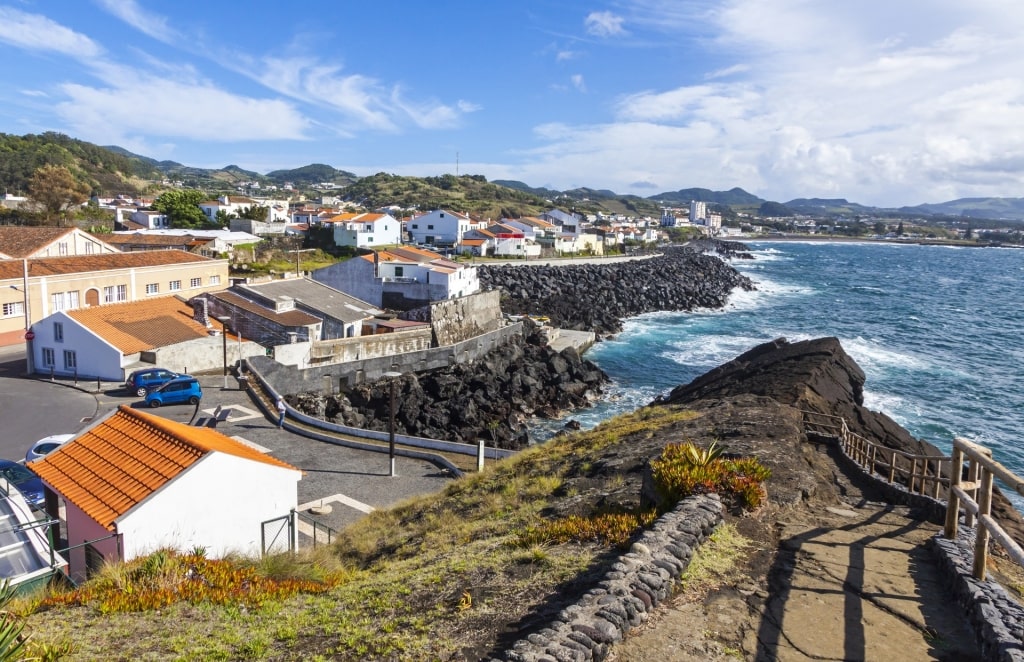
Ponta Delgada
While Ponta Delgada—the capital of Portugal’s nine-strong Azores archipelago—is technically a city, it retains the charisma of a smaller town.
This is especially true in the historic center, where basalt and limestone churches and heritage buildings sit alongside traditionally decorated restaurants serving Atlantic-inspired dishes.
Ponta Delgada’s best features, however, are gifted by nature. On the city’s peripherals, you can tour fragrant pineapple plantations and botanical gardens or even venture deep underground inside a lava tube, a testament to the volcanic nature of these isles.
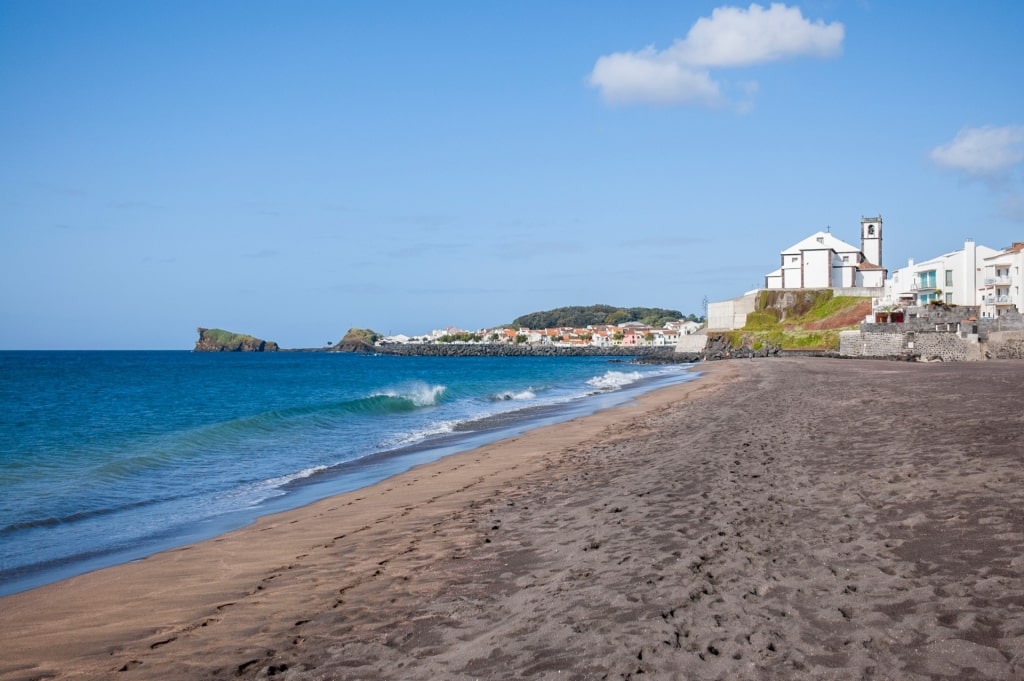
Praia das Milicias, Ponta Delgada
The volcanic theme continues across São Miguel Island’s charcoal-hued sands and pebble shores. Praia das Milicias, a popular beach in the Azores, is just a short drive from the town.
From Ponta Delgada’s marina, wildlife spotting boat trips depart to the deep blue year-round. Dolphins are a common sighting on these tours, yet it’s the chance to spot one of the Azores’ four species of resident whales that makes these sailings so tempting.
Read: Best Places to Go Whale Watching in the World
Vila do Conde
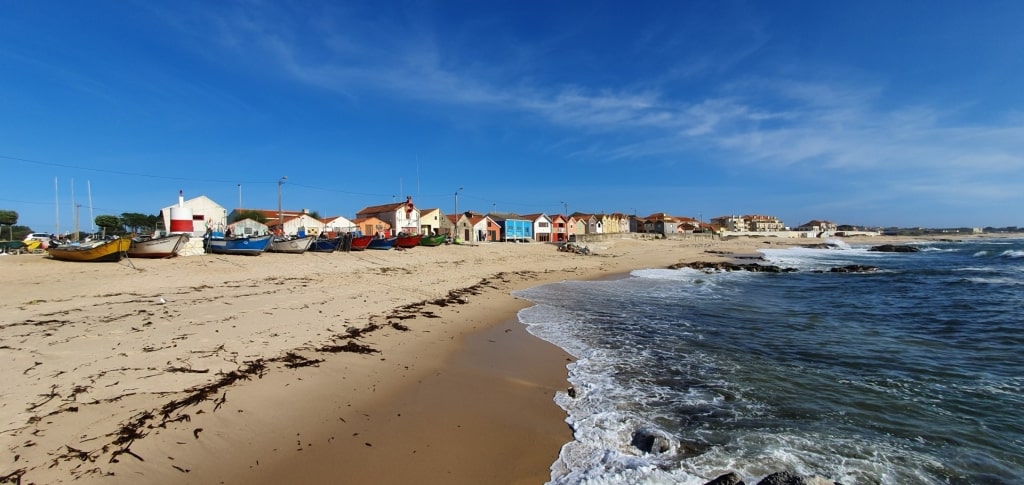
Vila do Conde
Set on the Costa Verde (Green Coast), named for the lush vegetation which backs this stretch of the shoreline, Vila do Conde is one of the best beach towns in Portugal’s north.
Just a 50-minute metro ride from Porto, this is an easy day trip from the country’s second city. Hugging the rambling River Ave, the town tracks the waterway towards the ocean, golden sands flanking either side of the river’s mouth.

Forte de São João Baptista, Vila do Conde
Follow the river’s flow and make a beeline to one of the beaches fronting the town, such as Praia do Seca, overlooked by the 16th-century Forte de São João Baptista. Ocean-facing bars line the beach, with the local and lightly sparkling Vinho Verde the perfect pairing on a summer’s day.
Another of the town’s main attractions is the Mosteiro de Santa Clara and its impressive aqueduct. The complex’s church was constructed in the 14th century, with the imposing monastery following later. Today, it’s regarded as one of the finest Gothic structures in Northern Portugal.
Read: Best Beaches in Porto, Portugal
Azenhas do Mar
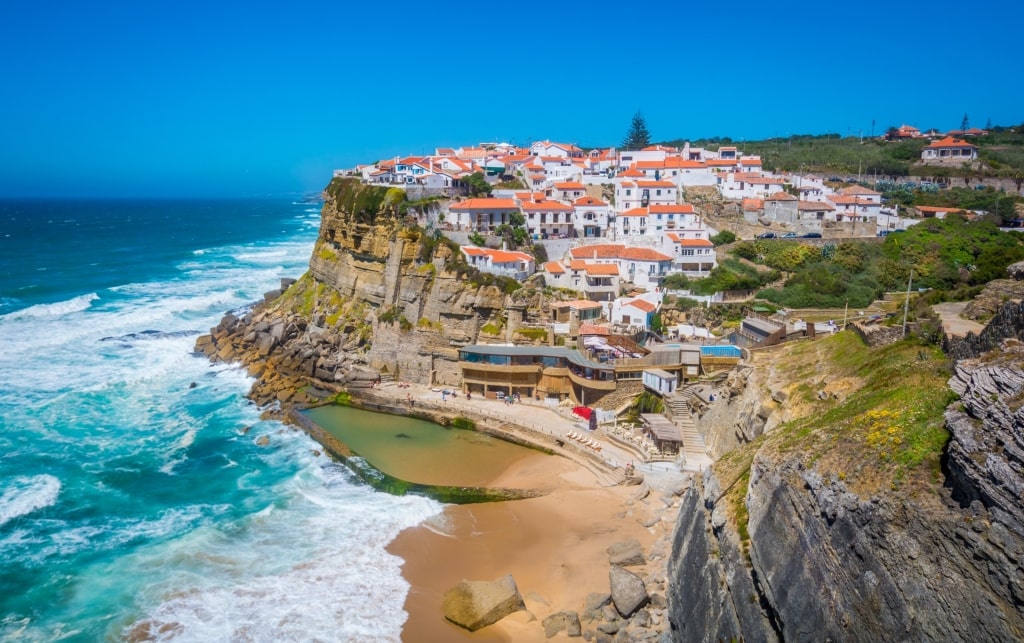
Azenhas do Mar
Less than an hour from Lisbon, clifftop-crowning Azenhas do Mar is not only one of the best beach towns in Portugal but a strong contender for the country’s prettiest.
Once a small fishing port, the village evolved over the years, maturing into a popular beach getaway for in-the-know Alfacinhas (Lisboners) eager to escape the city.
Nowadays, it’s less of a secret, partly due to the proximity of Sintra’s UNESCO-listed palaces, yet the panoramic setting is no less impressive nor adulterated.
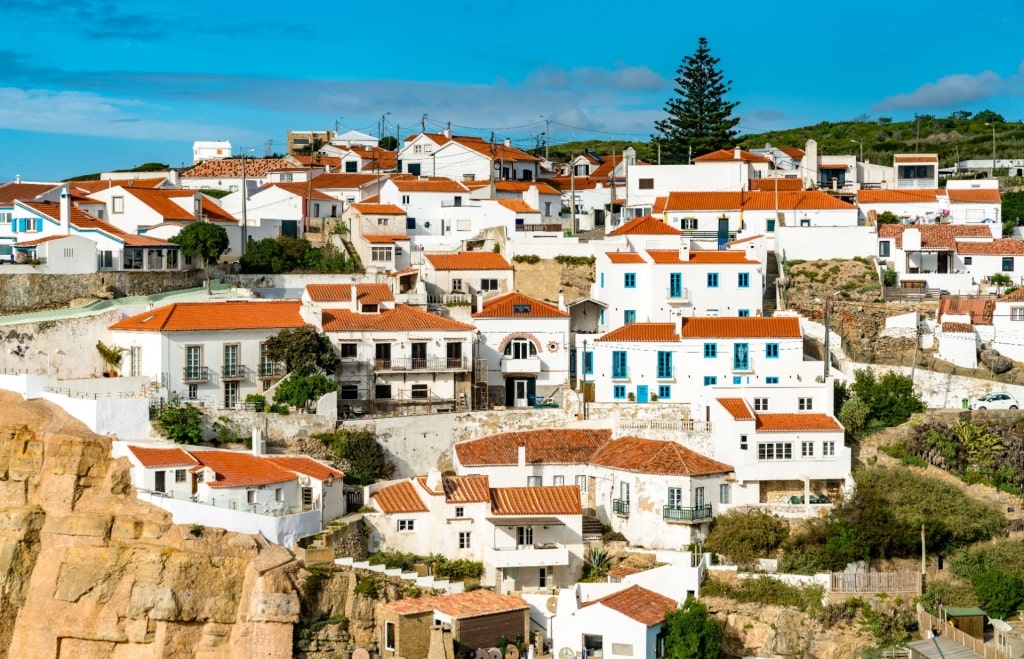
Azenhas do Mar
The cluster of whitewashed homes cascades down the cliff devoid of high-rises or resorts, and an air of authenticity lingers in the salt-infused breeze.
You can still spot occasional remnants of the village’s past—the name translates to “Watermills of the Sea”—by the public restrooms, where a traditional watermill house stands.
Undoubtedly, the main draw is the pocket-sized beach below, which makes for a scenic swim, especially inside the calm lido replenished by seawater. Admittedly, the beach all but disappears at high tide, but the vista remains equally enthralling.
Read: Best Things to Do in Sintra
Sesimbra
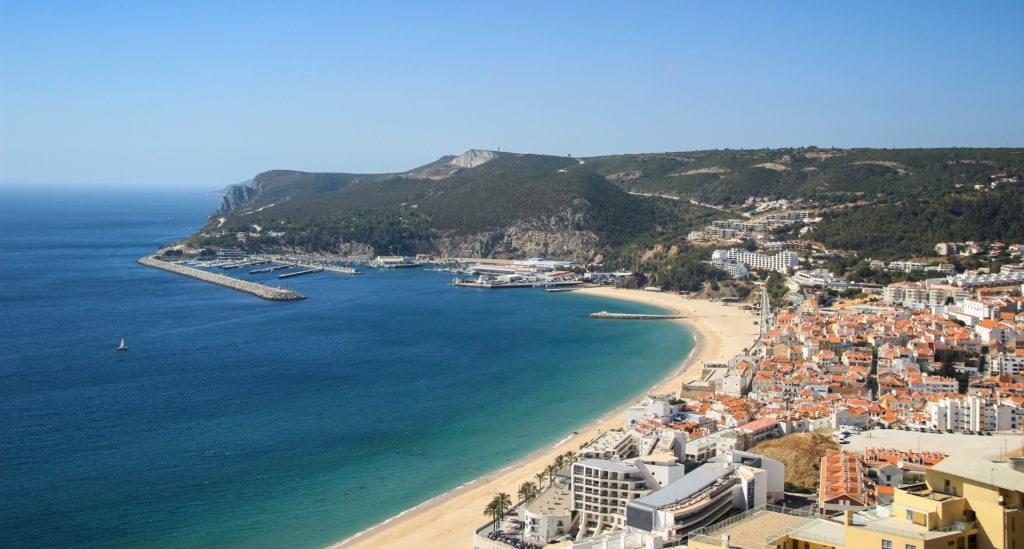
Sesimbra
A popular day trip from Lisbon, peaceful Sesimbra serves up all the seaside essentials you could wish for.
Tranquil turquoise waters lap on the gently curved shoreline, green-clad slopes cradle the town, and marisqueiras (seafood restaurants) grill the day’s catch to order. Choco frito (fried cuttlefish) is the local speciality, with the dishes roots in the nearby city of Setúbal.
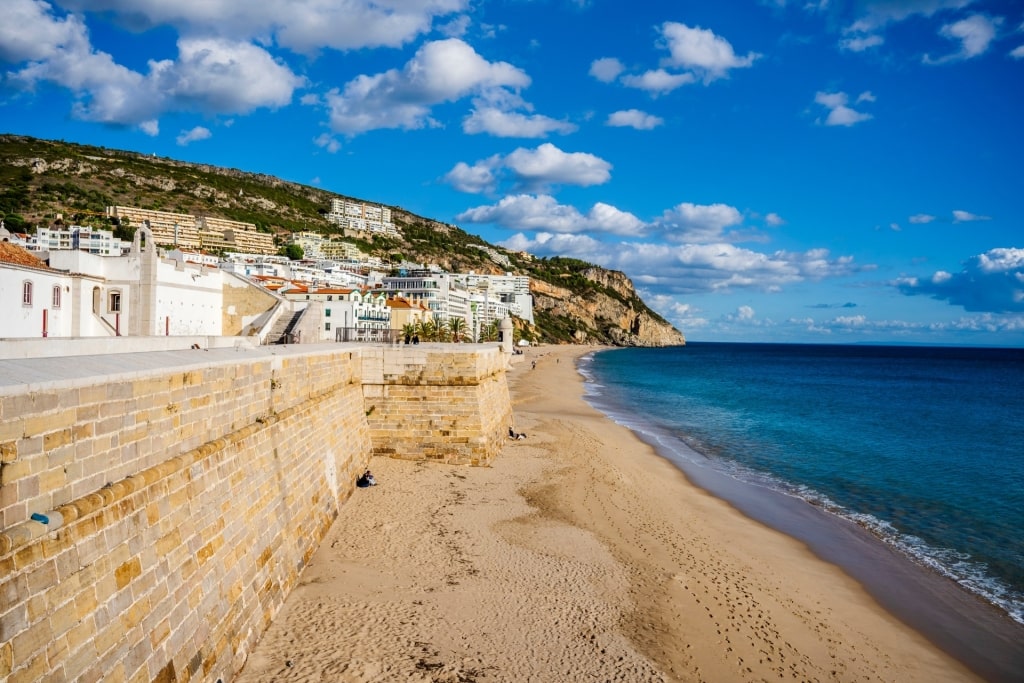
Forte de Santiago, Sesimbra
Fronting Sesimbra are some of Portugal’s best beaches, Praia do Ouro and Praia da Califórnia, separated by Forte de Santiago.
A nearly 300-year-old defensive structure, this fort has been reimagined as an open to all cultural space. High above, medieval Castelo de Sesimbra also stands guard, now providing an incredible panorama across the bay.
Still, what makes Sesimbra one of the best beach towns in Portugal is its surroundings, the Parque Natural da Arrábida.
This lush and mountainous reserve, densely coated by vegetation, is a haven for wildlife and beachgoers, and you’ll find some of the country’s most Caribbean-esque sands inside the park’s embrace.
Costa Nova (Aveiro)

Aveiro
Aveiro, an hour south of Porto, is often dubbed “the Venice of Portugal” thanks to its cluster of canals and hand-painted, high-prowed boats. But if you track those channels away from the art nouveau downtown, you’ll soon arrive at the equally colorful and enchanting Costa Nova peninsula.
Characterized by palheiros—striped two-tone cottages historically used to house fishermen and their equipment—the suburb retains some of its sleepy fishing village qualities.
However, following the salt trade boom of the 19th century, Costa Nova grew and is now often classed as one of the best beach towns in Portugal in its own right.
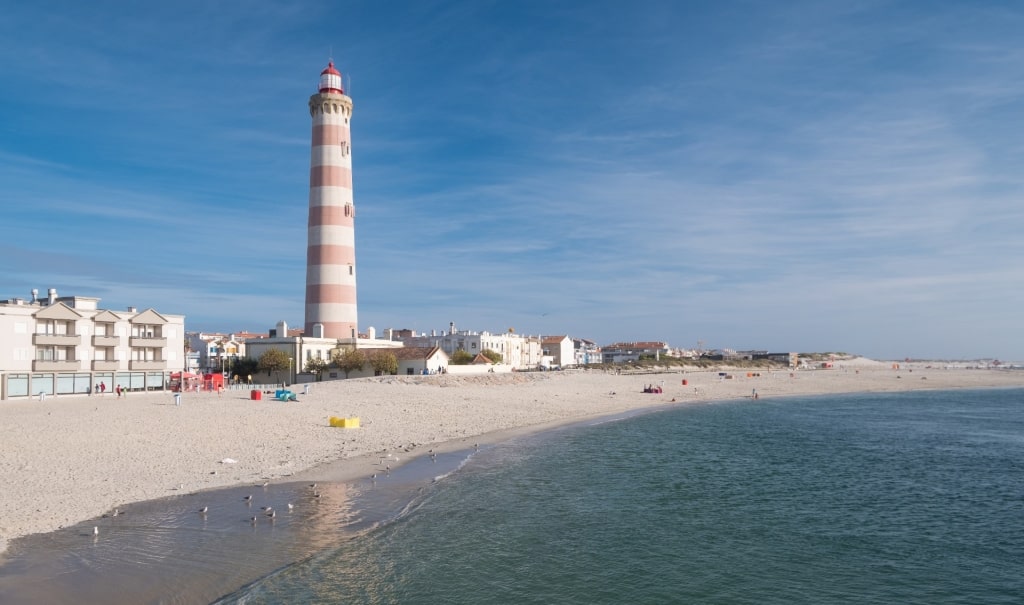
Praia da Barra, Aveiro
Beyond the typical cabins and premium seafood restaurants, the main draw is the pristine, dune-backed beach. On the Atlantic side, surf-friendly Praia da Barra blends into Praia da Costa Nova, creating a streak of sun-bleached sand as far as the eye can see.
Alternatively, settle on the Aveiro Lagoon for a more tranquil setting, where watersports and bird spotting are the order of the day.
For a spot of culture and to learn more about Portugal’s beloved bacalhau (salted cod fish), visit the Navio-Museu Santo André, housed onboard a decommissioned fishing trawler.
Vila Franca do Campo
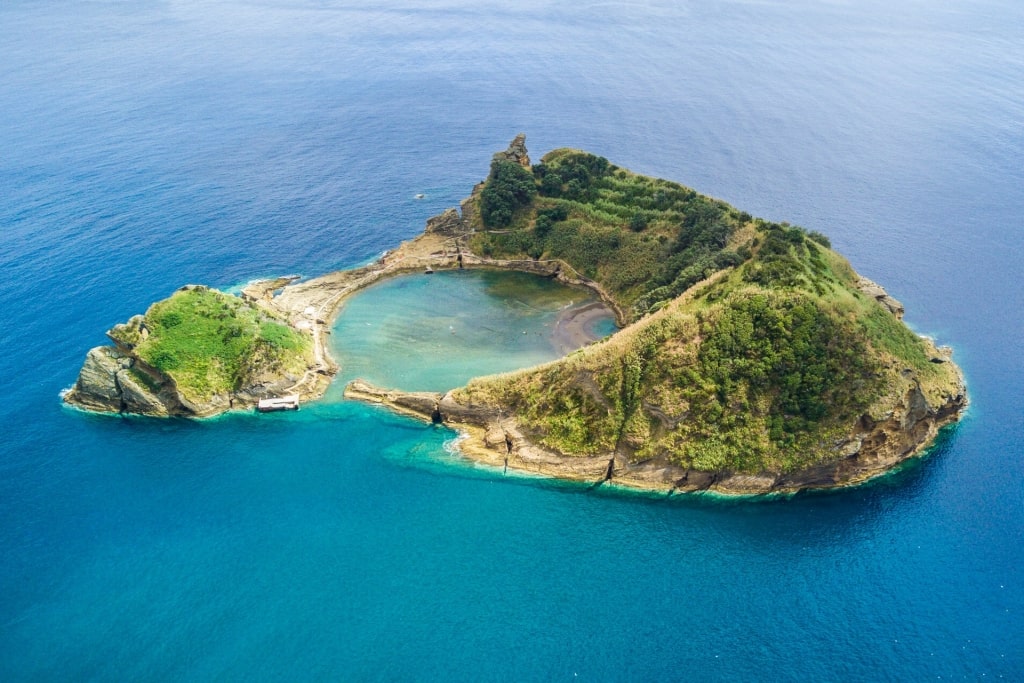
Vila Franca do Campo
On São Miguel Island, the largest of the Azores, Vila Franca do Campo promises a beach town with a twist; the chance to bathe inside an extinct volcano.
A short boat ride will whisk you to Ilhéu de Vila Franca do Campo, a protected islet open to visitors from late spring until autumn. Formed from the crater of an ancient volcano, this nature reserve offers one of the most unique places to swim, snorkel or sunbathe in the whole country.
While the beach itself is relatively compact, adding to the intimacy of the setting, the tranquil lake-like waters inside the “cone” offer a respite from some of the Azores’ more surf-heavy shorelines. As only 400 people are allowed access daily, advance booking is essential.
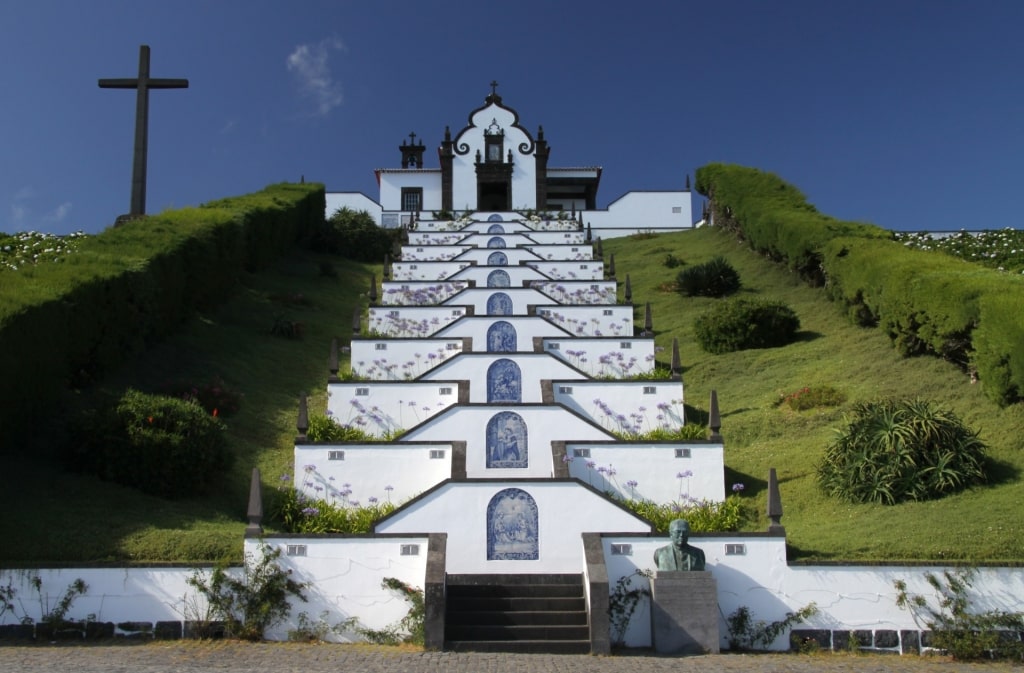
Ermida de Nossa Senhora da Paz, Vila Franca do Campo
Above the town, the Ermida de Nossa Senhora da Paz, an 18th-century hermitage, is worth a visit for the panorama alone. After climbing the intriguingly stacked staircase, you’ll enjoy a fantastic vista across the town and islet.
Post-hike, settle into one of the town’s small tabernas to sample grilled lapas (limpets), one of the Azores’ signature dishes.
Nazaré

Nazaré
Mention Nazaré to any competitive surfer and you’ll be showered with stories of awe. Renowned as the home of the world’s biggest waves—the largest surge surfed here reached an impressive 85 feet—this stretch of coast an hour and a half from Lisbon deserves its legendary status.
The best time to visit Portugal for the most ferocious waves is usually from late September to April, although the spectacle here is enthralling year-round.
Whether you’re taking it in from a surfboard or the viewing area inside Forte de São Miguel Arcanjo, these giant tides will leave you spellbound.

Praia da Nazare, Nazaré
Still, that doesn’t mean that Nazaré is exclusively for wave riders. On the other side of the headland, the much calmer and tanning-friendly Praia da Nazare curves gently in front of the laid-back town.
Seafood restaurants line the promenade, serving up local specialties such as octopus, cod fish, and tuna. Behind, the maze of weathered streets is dotted with small boutiques and independent souvenir stores.

Sitio de Nazaré, Nazaré
For a slice of Portugal’s patrimony—and some far-reaching views—ride the 19th-century funicular up to Sitio de Nazaré.
High above the town, the Santuário de Nossa Senhora da Nazaré, originally medieval but since reconstructed, dominates. The tilework inside is particularly exquisite.
Porto Moniz
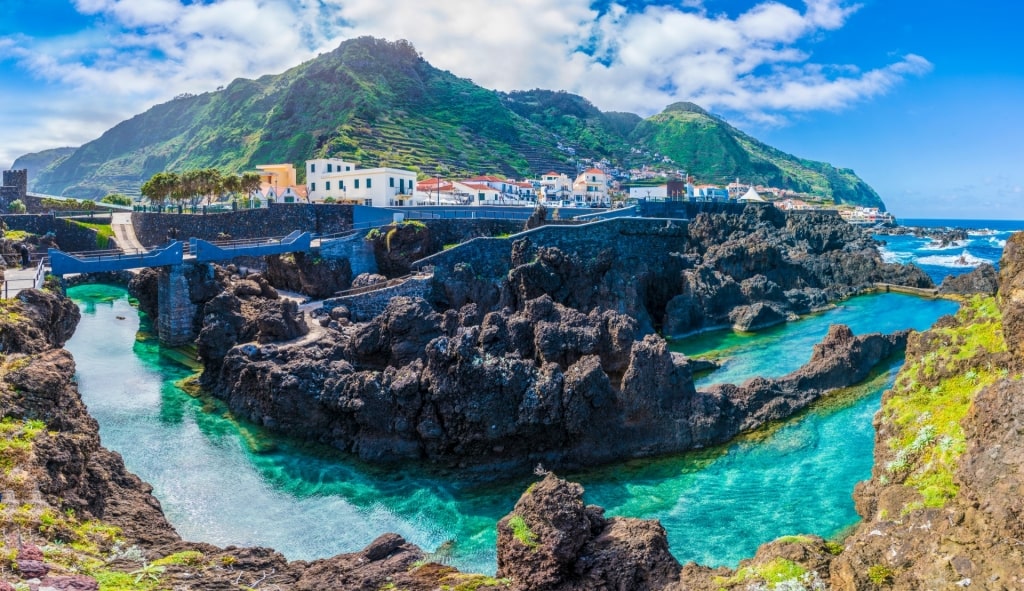
Porto Moniz
With its year-round semi-tropical climate, Madeira has established itself as one of Europe’s best beach destinations. Yet for the island’s most memorable swimming spot, you’ll want to head to Porto Moniz.
Set on the island’s northwest one hour from Funchal, this tiny beach town has been shaped by nature. Crashing Atlantic waves, fierce winter winds, and lava-spewing eruptions have all left their mark, crafting some of the world’s most unique bathing pools.
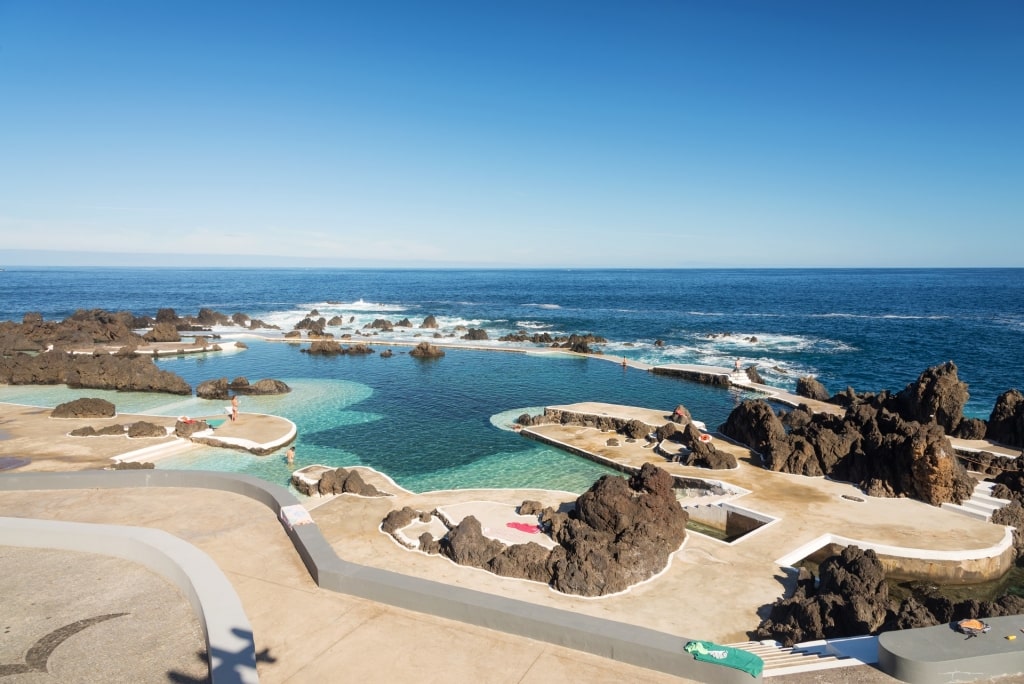
Porto Moniz
Whether you choose to splash into the rugged volcanic pools or the more polished family-friendly version, expect plenty of seawater tumbling over the volcanic-defined borders.
With Madeira’s signature soaring mountains flanking the town, you’ll cherish your experience at one of Portugal’s most beautiful places.
For more typical sands—and even then, they are the color of cocoa—visit nearby Seixal, where the backdrop of vegetation-coated cliffs and tumbling waterfalls provides another incredible bathing spot.
Read: Best Places to Visit in Portugal
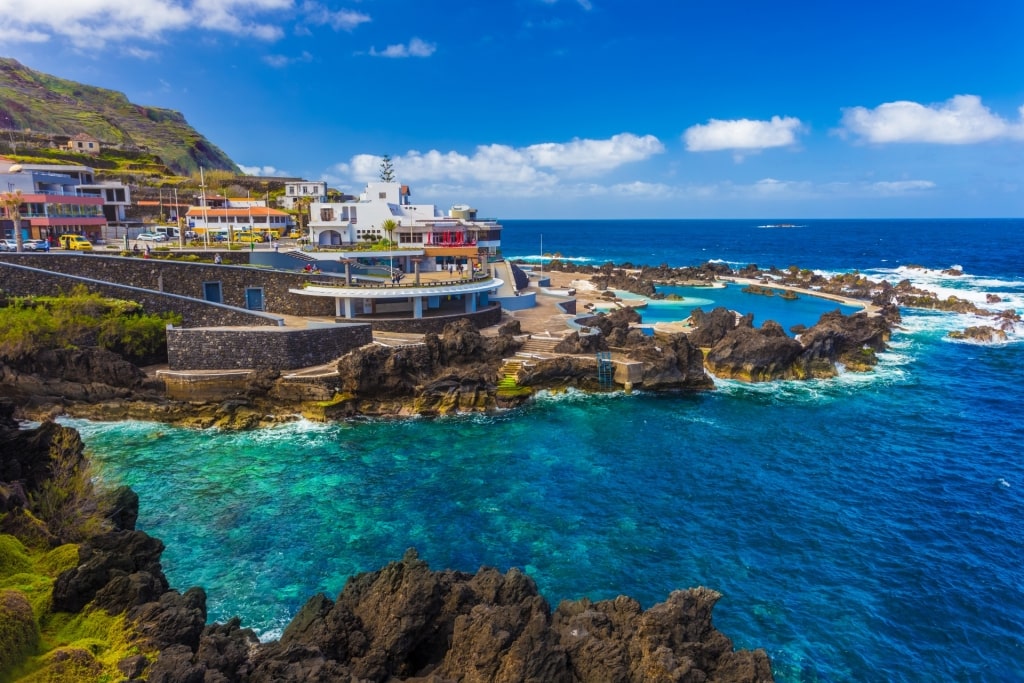
Porto Moniz
Ready to heed the call of Portugal’s coastal hideaways? Browse Celebrity’s Portugal cruises to find your next dream vacation.
